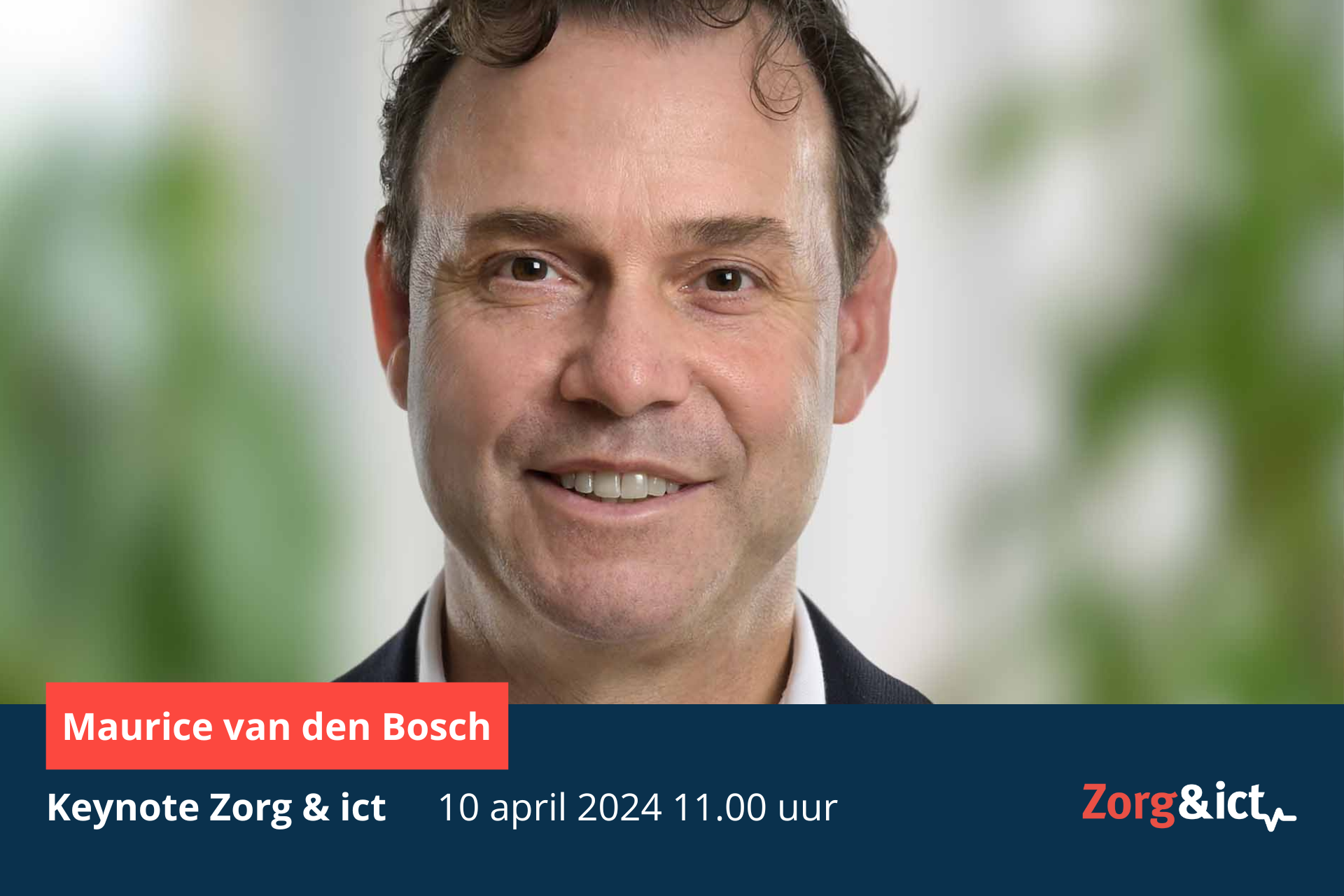Digital transformation is necessary to keep healthcare accessible while also making it more transparent and person-centered. This is the firm conviction of Antoni van Leeuwenhoek board chairman Maurice van den Bosch. Smart partnerships are needed to fulfill this promise. If only to reduce the current dependence on Big Tech.
A cure for every cancer, that is the mission the AvL has set for itself. A "Big Hairy Audacious Goal," the hospital cum research institute specializing in cancer acknowledges in an explanation of its long-term strategy, especially given the inevitable growth in the number of patients. According to IKNL figures, 1.4 million people will have or have had cancer by 2032. Just a few years ago, this figure was 800,000.
Accessibility
"One in two Dutch people will face cancer in their lifetime," Van den Bosch outlines the concrete impact of these numbers. "Not only do more people get diagnosed, but we also get more and more people who live longer with cancer and need to be followed in that trajectory. So the last thing we need to worry about in healthcare is too little work. What we do have responsibility for is maintaining accessibility and quality. Just more specialists won't get you there. You will have to think about how you can use technology to support staff."
Digital oncology
In doing so, Van den Bosch is looking explicitly at the development of new digital tools. He previously did that at the OLVG, where he was chairman of the board from 2017 until the end of last year. At the height of the corona epidemic, Van den Bosch made a name for himself by quickly introducing a corona check app together with supplier Luscii and sharing it with the rest of the Netherlands.
Within the AvL, where he has held the same position since January, Van den Bosch encounters a work culture that is steeped in digital thinking. Within the Digital Oncology program, he is investigating how the smart use of data and working with Artificial Intelligence can improve both research and diagnostics and treatment.
Person-centered diagnostics
Asked about the benefits of digital applications in oncology care, Van den Bosch thinks primarily of diagnostics. "That's where one of the biggest opportunities lies. Traditionally, in screening we use a one size fits all approach. Everyone goes through the same machinery. You do little or no risk stratification, while you want to be able to identify especially high-risk people. You can then screen them intensively. You don't want to put low-risk people through that kind of intensity. Such a person-oriented approach, in which you can filter out high-risk people relatively easily on the basis of genetic profiles, has an enormous impact. Because as you find tumors earlier, the survival rate goes up."
Clinical implementation
What such risk-driven screening can do is demonstrated by the example of the mammaprint. Thanks to this test, patients with a low risk of metastasis no longer have to undergo additional chemo. This is expected to spare at least five hundred women this burdensome treatment each year. Striking figures. Yet it took almost twenty years before the Health Care Institute included the test in the basic package. "The movement from science to clinical implementation and acceptance takes time," Van den Bosch observes dryly. "It shows how complex it is to implement an innovation at scale."
Making mistakes
This is not merely a matter of slow bureaucratic mills. Culture and attitude can also be a hindrance. As part of the digitization of diagnostics, AvL is paying close attention to AI-assisted digital image diagnostics. The advantages are obvious: unlike a flesh-and-blood physician, a computer can analyze endless digital images without getting tired.
Although great leaps have been made in this very area, it takes time to get all doctors on board. "As a rule, as a highly trained professional, it is difficult to recognize that parts of your work can also be done by a computer," Van den Bosch responds. As an interventional radiologist, Van den Bosch knows what he is talking about. "There is also discussion about margins of error. Computers make mistakes, but to colleagues I have to say that we also make mistakes. We do pretend that we score one hundred percent, but some comparative studies show that we score worse than the computer in parts."
Data-driven transparency
In addition to removing workloads and maintaining quality, Van den Bosch points out another factor that plays a role in further digitization of healthcare. "You see an increasing degree of transparency in all sectors. That has to do with this digital transformation. Before, the data just wasn't there. Now that we have started working data-driven it is. Healthcare is still relatively in-transparent. But it's getting easier and easier to make outcomes transparent and to compare those outcomes. This is increasingly happening between hospitals, such as in the Santeon group, in which OLVG works together with six other large hospitals. The next exciting step is that the patient will also have access. Ultimately, the patient is going to choose on that."
Patient empowerment
A small caveat is in order, Van de Bosch believes. The discussion about transparency and quality in the Netherlands in recent years has been conducted mainly in terms of volumes. As far as Van den Bosch is concerned, this is a relevant criterion: "In the treatment of prostate cancer, for example, we really see that the risk of incontinence and impotence is much lower with 400 operations per year than with 40 per year."
Still, he believes a broader view of volume and quality is needed. "If you only look at volume, you might encourage more surgery at the expense of other treatment options. So above all, let's look at the whole intervention package. Maybe we should start by agreeing on a standard dataset that we at least put on our websites. But that movement toward more transparency is 100 percent certain to happen. As we work more with data, we also empower the patient."
Dominance of tech companies
The growing patient input into digitization cannot disguise the fact that, for now, industry has a bigger say. Healthcare providers are often tied hand and foot to the main IT suppliers. The question arises to what extent the public interest is compromised by the dominance of large tech companies.
"Tech companies are becoming increasingly dominant, including within the healthcare system," Van den Bosch acknowledges. "That may be the hottest issue. They sometimes have returns of 30 to 40 percent. Then it is difficult to come to a partnership. But I do see opportunities for healthcare itself to move toward smart solutions."
Socially explainable returns
In this regard, Van den Bosch mentions companies such as BeterDichtbij and Luscii. "Those are consciously looking for socially explainable returns. That kind of partner is what healthcare needs to move forward." Yet when it comes to potential partners, Van den Bosch also looks a step further. "In healthcare we think very much from our own domain, while outside healthcare there are parties that have an interesting digital infrastructure and great experience with data analytics. Think of supermarket chains, KPN, Post NL or Bol.com. You have to be careful in the Netherlands to speak out in favor of cooperation with such parties, but if they were to say: we are going to organize care at a distance... They have the infrastructure, but not the healthcare knowledge. We do the opposite in healthcare by bringing in technological knowledge. Shouldn't you be looking at a partnership then?"
Positive developments
Within healthcare, Van de Bosch sees the necessary positive developments regarding digitization. Earlier this year, the parties to the Integral Care Agreement chose CumuluZ and Zorg bij Jou as the national infrastructure for data exchange. "The strength is that things are now coming together where before we were too fragmented and wanted to do it all ourselves," says Van den Bosch.
"That requires us to step over our own shadow and dare to accept that the final responsibility is not with everyone's own club. Health insurers are taking a good role in this. They act more as partners and challenge us to show progress. They work with milestones and deliverables on granted financial support. This creates a more interesting system than a few years ago, where people really keep each other on their toes with the understanding that delivery is needed for citizens."
Intellectual capital
With that, barrier-free data exchange is not yet a done deal, Van den Bosch realizes. "CumuluZ must now start proving itself. In terms of construction and clinical implementation, it still needs to be perfected. It will stand or fall with the right knowledge and expertise. Do you have the right specialists, engineers and data analysts available? At Santeon, we built the Santeon Health Intelligence Platform for the affiliated seven hospitals. Nearly thirty men worked on that full time for two years. Still, I remain an optimist. I believe very much in human intellectual capital. I would consider it strong if we choose one, two or three larger initiatives in the Netherlands. And put all available intelligence on that."
Steps after corona
Regardless of the pace at which Dutch healthcare is digitizing, the direction in which the sector is moving is fixed as far as Van den Bosch is concerned. "Not every Dutch person sees it, but a great deal has been digitized in healthcare in recent years. The corona pandemic was enormously impactful in this respect. Whether it's lung, heart, diabetes or HIV, at OLVG roughly 10 to 15 percent of all chronic care is digital these days. If I had 40 statuses on my desk ten years ago, that was a lot. Now we have a full blown EHR everywhere, there are apps for care at home and people can make appointments digitally. There are already AI models that make work easier and we have great national data sharing initiatives. Things may be faster and more impactful, but we are really making strides. This is why I am still convinced that the hospital of the future-as I once noted-is in the patient's inside pocket, especially for chronic care."
Maurice van den Bosch will act as keynote speaker during Zorg & ict 2024. The largest health tech event in the Netherlands will be held from April 9 to 11 at Jaarbeurs in Utrecht.












